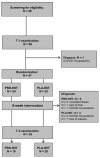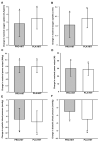Protein Supplementation Does Not Maximize Adaptations to Low-Volume High-Intensity Interval Training in Sedentary, Healthy Adults: A Placebo-Controlled Double-Blind Randomized Study
- PMID: 36235536
- PMCID: PMC9572362
- DOI: 10.3390/nu14193883
Protein Supplementation Does Not Maximize Adaptations to Low-Volume High-Intensity Interval Training in Sedentary, Healthy Adults: A Placebo-Controlled Double-Blind Randomized Study
Abstract
There is ample evidence that specific nutritional strategies can enhance adaptions to resistance and endurance training. However, it is still unclear whether post-session protein supplementation may increase the effects of low-volume high-intensity interval training (LOW-HIIT). We examined the impact of LOW-HIIT combined with protein vs. placebo supplementation on cardiometabolic health indices in sedentary healthy individuals. Forty-seven participants (31.1 ± 8.0 yrs) performed cycle ergometer LOW-HIIT (5−10x1 min at 80−95% maximum heart rate) for eight weeks and randomly received double-blinded 40 g of whey protein (PRO-HIIT, N = 24) or an isocaloric placebo (maltodextrin, PLA-HIIT, N = 23) after each session. The maximum oxygen uptake (VO2max, primary outcome) and several secondary cardiometabolic outcomes were determined pre-/post-intervention. VO2max increased in PRO-HIIT (+2.8 mL/kg/min, p = 0.003) and PLA-HIIT (+3.5 mL/kg/min, p < 0.001). Systolic and diastolic blood pressure decreased in PRO-HIIT (−7/3 mmHg, p < 0.05) and PLA-HIIT (−8/5 mmHg, p < 0.001). Gamma glutamyl transferase (−2 U/L, p = 0.003) decreased in PRO-HIIT and alanine aminotransferase (−3 U/L, p = 0.014) in PLA-HIIT. There were no significant between-group differences in any of the outcome changes. In conclusion, LOW-HIIT improved VO2max and other cardiometabolic markers irrespective of the supplementation condition. Post-session protein supplementation does not seem to provide any additional benefit to LOW-HIIT in improving cardiometabolic health in sedentary healthy individuals.
Keywords: HIIT; cardiometabolic health; cardiorespiratory fitness; whey protein.
Conflict of interest statement
The authors declare no conflict of interest.
Figures



Similar articles
-
Protein Supplementation Increases Adaptations to Low-Volume, Intra-Session Concurrent Training in Untrained Healthy Adults: A Double-Blind, Placebo-Controlled, Randomized Trial.Nutrients. 2024 Aug 15;16(16):2713. doi: 10.3390/nu16162713. Nutrients. 2024. PMID: 39203849 Free PMC article. Clinical Trial.
-
Effects of high-intensity interval training compared to moderate-intensity continuous training on maximal oxygen consumption and blood pressure in healthy men: A randomized controlled trial.Biomedica. 2019 Sep 1;39(3):524-536. doi: 10.7705/biomedica.4451. Biomedica. 2019. PMID: 31584766 Free PMC article. Clinical Trial.
-
Six high-intensity interval training sessions over 5 days increases maximal oxygen uptake, endurance capacity, and sub-maximal exercise fat oxidation as much as 6 high-intensity interval training sessions over 2 weeks.J Sport Health Sci. 2021 Jul;10(4):478-487. doi: 10.1016/j.jshs.2020.06.008. Epub 2020 Jun 18. J Sport Health Sci. 2021. PMID: 32565243 Free PMC article.
-
High intensity interval training combined with L-citrulline supplementation: Effects on physical performance in healthy older adults.Exp Gerontol. 2020 Oct 15;140:111036. doi: 10.1016/j.exger.2020.111036. Epub 2020 Jul 25. Exp Gerontol. 2020. PMID: 32721549 Review.
-
Effects of different protocols of high intensity interval training for VO2max improvements in adults: A meta-analysis of randomised controlled trials.J Sci Med Sport. 2019 Aug;22(8):941-947. doi: 10.1016/j.jsams.2019.01.013. Epub 2019 Jan 29. J Sci Med Sport. 2019. PMID: 30733142
Cited by
-
Protein Supplementation Increases Adaptations to Low-Volume, Intra-Session Concurrent Training in Untrained Healthy Adults: A Double-Blind, Placebo-Controlled, Randomized Trial.Nutrients. 2024 Aug 15;16(16):2713. doi: 10.3390/nu16162713. Nutrients. 2024. PMID: 39203849 Free PMC article. Clinical Trial.
References
-
- Lear S.A., Hu W., Rangarajan S., Gasevic D., Leong D., Iqbal R., Casanova A., Swaminathan S., Anjana R.M., Kumar R., et al. The effect of physical activity on mortality and cardiovascular disease in 130,000 people from 17 high-income, middle-income, and low-income countries: The PURE study. Lancet. 2017;390:2643–2654. doi: 10.1016/S0140-6736(17)31634-3. - DOI - PubMed
-
- Lee I.M., Shiroma E.J., Lobelo F., Puska P., Blair S.N., Katzmarzyk P.T., Lancet Physical Activity Series Working Group Effect of physical inactivity on major non-communicable diseases worldwide: An analysis of burden of disease and life expectancy. Lancet. 2012;380:219–229. doi: 10.1016/S0140-6736(12)61031-9. - DOI - PMC - PubMed
Publication types
MeSH terms
Substances
Grants and funding
LinkOut - more resources
Full Text Sources

